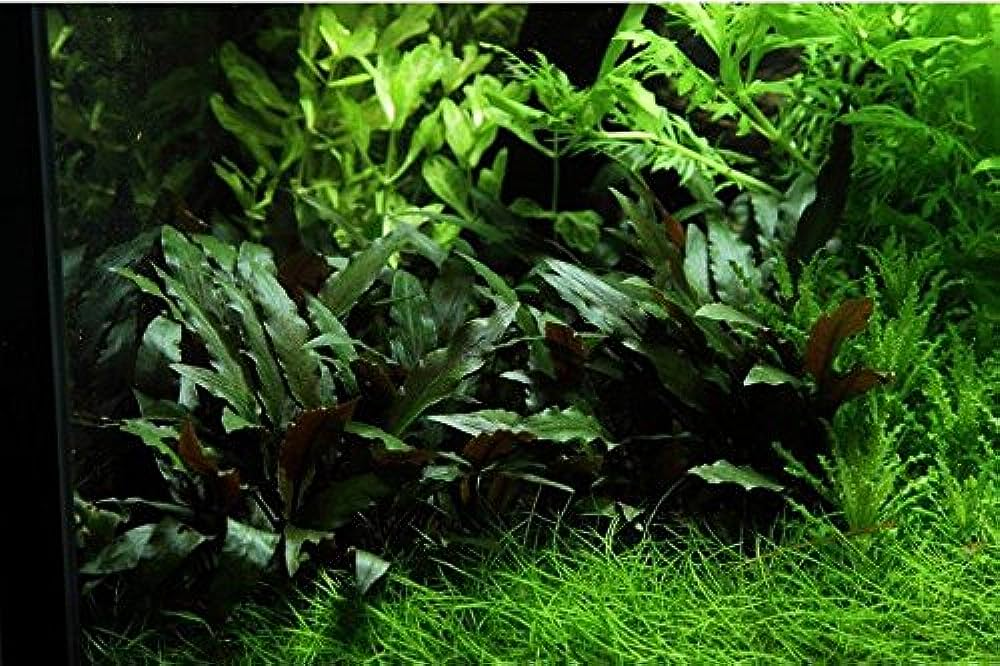Cryptocoryne Beckettii aka Petchii
$6
Water Trumpet is also known as Petchii and C Becketii.
Popular crypt plant called the Water trumpet creates a lovely mid-ground accent or centerpiece. Green back or mid-ground plants stand out sharply against its crimson, ruffle-textured, rectangular leaves. As one of the simpler crypts to maintain, water trumpet is a popular choice for beginners. Water trumpets, like all crypt plants, are delicate to changes in water conditions and dislike being moved. When a new tank is brought to the facility or if the water conditions are drastically altered, "crypt melt" is a common occurrence. The plant's leaves start to decay and basically disappear as a result. If this happens, you can remove any rot and make an effort to stabilize the water. Once they have adapted, they should start to grow again. If the illumination is too harsh, these plants will melt as well. This plant can tolerate low to moderate illumination levels.
In streams or rivers with swiftly moving limestone beds, the majority of crypt plants were first discovered. These plants require high calcium concentrations, as well as CO2, phosphate, iron, and nitrate, to flourish in a tank environment. They can generate blossoms above the water even though it is easier for them to grow submerged. They will also grow emersed. Water trumpets can be inserted into the substrate or fastened with cotton thread or fishing wire to a rock or piece of driftwood.
Water trumpets spread via runners, which can be removed and replanted in the substrate at will. Plant each stem around an inch apart for adequate coverage. As long as all of the roots have access to nutrients from the substrate, water trumpets can also be planted in bunches.
Popular crypt plant called the Water trumpet creates a lovely mid-ground accent or centerpiece. Green back or mid-ground plants stand out sharply against its crimson, ruffle-textured, rectangular leaves. As one of the simpler crypts to maintain, water trumpet is a popular choice for beginners. Water trumpets, like all crypt plants, are delicate to changes in water conditions and dislike being moved. When a new tank is brought to the facility or if the water conditions are drastically altered, "crypt melt" is a common occurrence. The plant's leaves start to decay and basically disappear as a result. If this happens, you can remove any rot and make an effort to stabilize the water. Once they have adapted, they should start to grow again. If the illumination is too harsh, these plants will melt as well. This plant can tolerate low to moderate illumination levels.
In streams or rivers with swiftly moving limestone beds, the majority of crypt plants were first discovered. These plants require high calcium concentrations, as well as CO2, phosphate, iron, and nitrate, to flourish in a tank environment. They can generate blossoms above the water even though it is easier for them to grow submerged. They will also grow emersed. Water trumpets can be inserted into the substrate or fastened with cotton thread or fishing wire to a rock or piece of driftwood.
Water trumpets spread via runners, which can be removed and replanted in the substrate at will. Plant each stem around an inch apart for adequate coverage. As long as all of the roots have access to nutrients from the substrate, water trumpets can also be planted in bunches.
Family Name: Araceae
Origin: South Asia
Height: 4-6”
pH: 5.5-8.0
Care: Medium
Light: Moderate
Co2: Recommended
Propagation: Runners
Growth rate: Slow



